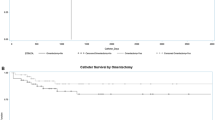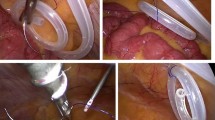Abstract
Background
Laparoscopy revolutionized many General Surgery procedures by decreasing hospital stay, minimizing recovery time, and reducing wound infection rates. This study evaluates the potential benefits of laparoscopic approach to peritoneal dialysis catheter (PDC) placement.
Methods
The American College of Surgeons National Surgical Quality Improvement Program database was queried for laparoscopic and open PDC placement. We evaluated patient demographics, comorbidities, operative time, length of stay (LOS), and postoperative outcomes. Univariate comparison and multivariate logistic regression analysis (MVA) adjusting for confounding factors including age, body mass index (BMI), comorbidities, and preoperative conditions were performed.
Results
A total of 3134 patients undergoing PDC placement were recorded in the NSQIP database between 2005 and 2012, including 2412 laparoscopic cases (LPDC) (77 %) and 722 open (OPDC). Overall, the majority of cases were performed by General Surgeons (81 %) with most of the remainder completed by Vascular Surgeons (16.8 %). Patients undergoing LPDC versus OPDC demonstrated no significant difference in gender (54 vs. 56 % males, p = 0.4), smoking history (8.5 ± 18.3 vs. 7.2 ± 16.9 pack years, p = 0.06), diabetes (42 vs. 40 %, p = 0.4), COPD (4.6 vs. 5 %, p = 0.63), or preoperative dialysis requirement (72 vs. 73 %, p = 0.6), but they were younger (57.2 ± 14.8 vs. 60.5 ± 15.9 years, p = 0.05) and had a higher BMI (29.3 vs. 29 kg/m2, p = 0.04). In univariate analysis of LPDC versus OPDC, overall wound complications (1.6 vs. 2.9 %, p = 0.02), deep surgical site infections (0.12 vs. 0.83 %, p < 0.006), minor complications (3.8 vs. 6.5 %, p < 0.05), major complications (4.3 vs. 6.9 %, p < 0.05), and LOS (1.8 ± 11.9 vs. 4.4 ± 10 days, p < 0.0001) favored the LPDC approach, but only operative time (57.6 ± 4.6 vs. 71.8 ± 5.3, p < 0.001) remained significant in MVA after controlling for confounding factors. Both LPDC and OPDC had equivalently low rates of catheter failure (0.21 vs. 0.14 %, p = 0.7).
Conclusion
Using univariate analysis, there appears to be a benefit from LPDC placement. However, after controlling for confounding variables, the techniques appear to have equal outcomes. Surgeons should perform a LPDC or OPDC according to the approach with which they are most familiar. However, continued adoption, dispersal, and refinement of the laparoscopic approach may further optimize patient outcomes.
Similar content being viewed by others
References
Collins AJ, Foley RN, Chavers B, Gilbertson D, Herzog C, Ishani A, Johansen K, Kasiske BL, Kutner N, Liu J, St Peter W, Guo H, Hu Y, Kats A, Li S, Li S, Maloney J, Roberts T, Skeans M, Snyder J, Solid C, Thompson B, Weinhandl E, Xiong H, Yusuf A, Zaun D, Arko C, Chen SC, Daniels F, Ebben J, Frazier E, Johnson R, Sheets D, Wang X, Forrest B, Berrini D, Constantini E, Everson S, Eggers P, Agodoa L (2014) US renal data system 2013 annual data report. Am J Kidney Dis 63(1 Suppl):A7. doi:10.1053/j.ajkd.2013.11.001
Jain AK, Blake P, Cordy P, Garg AX (2012) Global trends in rates of peritoneal dialysis. J Am Soc Nephrol: JASN 23(3):533–544. doi:10.1681/asn.2011060607
Asif A (2005) Peritoneal dialysis catheter insertion. Minerva Chir 60(5):417–428
Gajjar AH, Rhoden DH, Kathuria P, Kaul R, Udupa AD, Jennings WC (2007) Peritoneal dialysis catheters: laparoscopic versus traditional placement techniques and outcomes. Am J Surg 194(6):872–875. doi:10.1016/j.amjsurg.2007.08.038 (discussion 875-876)
Cope C, Kramer MS (1974) Letter: laparoscopic retrieval of dialysis catheter. Ann Intern Med 81(1):121
Crabtree JH, Fishman A (1996) Laparoscopic epiplopexy of the greater omentum and epiploic appendices in the salvaging of dysfunctional peritoneal dialysis catheters. Surg Laparosc Endosc 6(3):176–180
Amerling R, Maele DV, Spivak H, Lo AY, White P, Beaton H, Rudick J (1997) Laparoscopic salvage of malfunctioning peritoneal catheters. Surg Endosc 11(3):249–252
Barone GW, Johnson DD, Webb JW (1998) A practical approach to laparoscopic surgery for malfunctioning peritoneal dialysis catheters. J Laparoendosc Adv Surg Tech A 8(1):19–23
Lee M, Donovan JF (2002) Laparoscopic omentectomy for salvage of peritoneal dialysis catheters. J Endourol/Endourol Soc 16(4):241–244. doi:10.1089/089277902753752214
Santarelli S, Zeiler M, Marinelli R, Monteburini T, Federico A, Ceraudo E (2006) Videolaparoscopy as rescue therapy and placement of peritoneal dialysis catheters: a thirty-two case single centre experience. Nephrol Dial Transplant 21(5):1348–1354. doi:10.1093/ndt/gfk041
Yilmazlar T, Kirdak T, Bilgin S, Yavuz M, Yurtkuran M (2006) Laparoscopic findings of peritoneal dialysis catheter malfunction and management outcomes. Perit Dial Int: J Int Soc Perit Dial 26(3):374–379
Caliskan K, Nursal TZ, Tarim AM, Noyan T, Moray G, Haberal M (2007) The adequacy of laparoscopy for continuous ambulatory peritoneal dialysis procedures. Transpl Proc 39(5):1359–1361. doi:10.1016/j.transproceed.2007.02.088
Numanoglu A, McCulloch MI, Van Der Pool A, Millar AJ, Rode H (2007) Laparoscopic salvage of malfunctioning Tenckhoff catheters. J Laparoendosc Adv Surg Tech A 17(1):128–130. doi:10.1089/lap.2006.0542
Aasvang EK, Hansen JB, Kehlet H (2008) Can preoperative electrical nociceptive stimulation predict acute pain after groin herniotomy? J Pain 9(10):940–944. doi:10.1016/j.jpain.2008.05.015
Goh YH (2008) Omental folding: a novel laparoscopic technique for salvaging peritoneal dialysis catheters. Perit Dial Int: J Int Soc Perit Dial 28(6):626–631
Brandt CP, Franceschi D (1994) Laparoscopic placement of peritoneal dialysis catheters in patients who have undergone prior abdominal operations. J Am Coll Surg 178(5):515–516
Nijhuis PH, Smulders JF, Jakimowicz JJ (1996) Laparoscopic introduction of a continuous ambulatory peritoneal dialysis (CAPD) catheter by a two-puncture technique. Surg Endosc 10(6):676–679
Watson DI, Paterson D, Bannister K (1996) Secure placement of peritoneal dialysis catheters using a laparoscopic technique. Surg Laparosc Endosc 6(1):35–37
Lu CT, Watson DI, Elias TJ, Faull RJ, Clarkson AR, Bannister KM (2003) Laparoscopic placement of peritoneal dialysis catheters: 7 years experience. ANZ J Surg 73(3):109–111
Schmidt SC, Pohle C, Langrehr JM, Schumacher G, Jacob D, Neuhaus P (2007) Laparoscopic-assisted placement of peritoneal dialysis catheters: implantation technique and results. J Laparoendosc Adv Surg Tech A 17(5):596–599. doi:10.1089/lap.2006.0162
Crabtree JH, Burchette RJ (2009) Effective use of laparoscopy for long-term peritoneal dialysis access. Am J Surg 198(1):135–141. doi:10.1016/j.amjsurg.2008.10.019
Attaluri V, Lebeis C, Brethauer S, Rosenblatt S (2010) Advanced laparoscopic techniques significantly improve function of peritoneal dialysis catheters. J Am Coll Surg 211(6):699–704. doi:10.1016/j.jamcollsurg.2010.08.010
Ma JJ, Chen XY, Zang L, Mao ZH, Wang ML, Lu AG, Li JW, Feng B, Dong F, Zheng MH (2013) Laparoscopic peritoneal dialysis catheter implantation with an intra-abdominal fixation technique: a report of 53 cases. Surg Laparosc Endosc Percutan Tech 23(6):513–517. doi:10.1097/SLE.0b013e31828fa6ae
Crabtree JH, Fishman A (1999) Videolaparoscopic implantation of long-term peritoneal dialysis catheters. Surg Endosc 13(2):186–190
Sauerland S, Jaschinski T, Neugebauer EA (2010) Laparoscopic versus open surgery for suspected appendicitis. Cochrane Database Syst Rev 10:CD001546. doi:10.1002/14651858.CD001546.pub3
Perissat J, Collet D, Belliard R, Desplantez J, Magne E (1992) Laparoscopic cholecystectomy: the state of the art. A report on 700 consecutive cases. World J Surg 16(6):1074–1082
Soper NJ, Stockmann PT, Dunnegan DL, Ashley SW (1992) Laparoscopic cholecystectomy. The new ‘gold standard’? Arch Surg 127(8):917–921 (discussion 921-913)
Khuri SF, Daley J, Henderson W, Barbour G, Lowry P, Irvin G, Gibbs J, Grover F, Hammermeister K, Stremple JF et al (1995) The National Veterans Administration Surgical Risk Study: risk adjustment for the comparative assessment of the quality of surgical care. J Am Coll Surg 180(5):519–531
Khuri SF, Daley J, Henderson W, Hur K, Demakis J, Aust JB, Chong V, Fabri PJ, Gibbs JO, Grover F, Hammermeister K, Irvin G 3rd, McDonald G, Passaro E Jr, Phillips L, Scamman F, Spencer J, Stremple JF (1998) The Department of Veterans Affairs’ NSQIP: the first national, validated, outcome-based, risk-adjusted, and peer-controlled program for the measurement and enhancement of the quality of surgical care. National VA Surgical Quality Improvement Program. Ann Surg 228(4):491–507
Ross SW, Oommen B, Wormer BA, Walters AL, Matthews BD, Heniford BT, Augenstein VA (2015) National outcomes of laparoscopic Heller myotomy: operative complications and risk factors for adverse events. Surg Endosc. doi:10.1007/s00464-014-4054-0
Draganic B, James A, Booth M, Gani JS (1998) Comparative experience of a simple technique for laparoscopic chronic ambulatory peritoneal dialysis catheter placement. Aust N Z J Surg 68(10):735–739
Ogunc G, Tuncer M, Ogunc D, Yardimsever M, Ersoy F (2003) Laparoscopic omental fixation technique versus open surgical placement of peritoneal dialysis catheters. Surg Endosc 17(11):1749–1755. doi:10.1007/s00464-002-8586-3
Li JR, Chen WM, Yang CK, Shu KH, Ou YC, Ho HC, Cheng CL, Yang CR, Chiu KY (2011) A novel method of laparoscopy-assisted peritoneal dialysis catheter placement. Surg Laparosc Endosc Percutan Tech 21(2):106–110. doi:10.1097/SLE.0b013e31820af4ad
Gadallah MF, Pervez A, El-Shahawy MA, Sorrells D, Zibari G, McDonald J, Work J (1999) Peritoneoscopic versus surgical placement of peritoneal dialysis catheters: a prospective randomized study on outcome. Am J Kidney Dis 33(1):118–122
Jwo SC, Chen KS, Lee CC, Chen HY (2010) Prospective randomized study for comparison of open surgery with laparoscopic-assisted placement of Tenckhoff peritoneal dialysis catheter—a single center experience and literature review. J Surg Res 159(1):489–496. doi:10.1016/j.jss.2008.09.008
Tsimoyiannis EC, Siakas P, Glantzounis G, Toli C, Sferopoulos G, Pappas M, Manataki A (2000) Laparoscopic placement of the Tenckhoff catheter for peritoneal dialysis. Surg Laparosc Endosc Percutan Tech 10(4):218–221
Wright MJ, Bel’eed K, Johnson BF, Eadington DW, Sellars L, Farr MJ (1999) Randomized prospective comparison of laparoscopic and open peritoneal dialysis catheter insertion. Perit Dial Int: J Int Soc Perit Dial 19(4):372–375
Crabtree JH, Fishman A (2005) A laparoscopic method for optimal peritoneal dialysis access. Am Surg 71(2):135–143
Lund L, Jonler M (2007) Peritoneal dialysis catheter placement: Is laparoscopy an option? Int Urol Nephrol 39(2):625–628. doi:10.1007/s11255-007-9193-y
Strippoli GF, Tong A, Johnson D, Schena FP, Craig JC (2004) Catheter type, placement and insertion techniques for preventing peritonitis in peritoneal dialysis patients. Cochrane Database Syst Rev 4:CD004680. doi:10.1002/14651858.CD004680.pub2
Hauch AT, Lundberg PW, Paramesh AS (2014) Laparoscopic techniques enable peritoneal dialysis in the difficult abdomen. JSLS: J Soc Laparoendosc Surg/Soc Laparoendosc Surg. doi:10.4293/jsls.2014.002334
Davis WT, Dageforde LA, Moore DE (2014) Laparoscopic versus open peritoneal dialysis catheter insertion cost analysis. J Surg Res 187(1):182–188. doi:10.1016/j.jss.2013.09.041
Haggerty SM, Roth S, Walsh D, Stefanidis D, Price R, Fanelli RD, Penner T, Richardson W (2015) Guidelines for laparoscopic peritoneal dialysis access surgery. http://www.sages.org/publications/guidelines/guidelines-laparoscopic-peritoneal-dialysis-access-surgery/. Accessed Jan 2015
Crabtree JH (2014) SAGES guidelines for laparoscopic peritoneal dialysis access surgery. Surg Endosc 28(11):3013–3015. doi:10.1007/s00464-014-3812-3
Disclosures
Drs. Heniford and Augenstein have previously been awarded surgical research and education grants and honoraria from W.L. Gore and Associates, Ethicon, Novadaq, Bard/Davol, and LifeCell Inc. Dr. Kercher has received honoraria from Bard/Davol and Ethicon. Drs. Cox, Huntington, Blair, and Tanushree Prasad have no potential conflicts or disclosures relevant to this work.
Author information
Authors and Affiliations
Corresponding authors
Rights and permissions
About this article
Cite this article
Cox, T.C., Blair, L.J., Huntington, C.R. et al. Laparoscopic versus open peritoneal dialysis catheter placement. Surg Endosc 30, 899–905 (2016). https://doi.org/10.1007/s00464-015-4297-4
Received:
Accepted:
Published:
Issue Date:
DOI: https://doi.org/10.1007/s00464-015-4297-4




